Classic Buttermilk Scones
Tender and flaky, this buttermilk scones recipe makes the perfect addition to afternoon tea, a brunch spread, or a morning cup of coffee! Serve these scones plain, with clotted cream or fruit preserves, or mix in fresh fruit (blueberries are my favorite!) or a variety of other options for a sweet or savory scone you’ll want to enjoy again and again.
Welcome to the January Bake-Along!
Ahhh flaky, beautifully baked scones. Perfect for breakfast or dessert. Is there a more perfect concoction? I should think not. I fell in love with them the very first time I made chocolate chip scones, which was years before Brown Eyed Baker was given life. Since then, I have made my fair share of scones, from sweet potato scones and pumpkin scones to cinnamon sugar scones, oatmeal peanut butter chocolate chip scones, and countless more in between.
In addition to being delicious, scones are also extremely versatile and unbelievably quick to pull together. One (or two, at the most) bowl, a little mixing, a knead or two, patting into place, cutting, and then into the oven they go. They are perfect for last-minute company when you only have a few moments to throw something together.
If you are new to making scones or just want to learn a little more about these perfect pastries, pull up a seat and grab a warm cup of coffee because I am sharing everything I have learned over the years about making these tempting treats!
What are scones?
Tender, flaky buttermilk scones originated in the UK. Part biscuit and part muffin, these slightly sweet treats typically appear at tea time but also make an excellent breakfast or snack. One of the major hallmarks of a good English scone recipe is the ability to easily break them apart.
What is the secret to making good scones?
Trust me when I tell you there is nothing quite like a well-made scone. The secret to making light and flaky scones every time comes down to a few important things to note.
- Use fresh baking powder. Buttermilk scones depend on a reaction between baking powder and buttermilk to get a beautiful rise. This means you might want to test your baking powder before using it to make sure it’s fresh. Simply stir together 1 cup of warm water with 2 teaspoons of baking powder- if it fizzes you are good to go!
- Don’t over-work the dough. The longer you stir the dough together the more you activate the gluten in the flour. This results in a tough, less flaky scone.
- Use cake flour. Cake flour contains less gluten than all-purpose flour which results in a lighter, flakier scone. I use a mixture of all-purpose and cake flour to get perfectly light scones every time.
How to make buttermilk scones
Made with pantry staple ingredients and in one bowl, these delectable scones can be prepped, baked, and on the table in less than 45 minutes. Here’s how you can make them:
- Preheat the oven to 375°F and line a baking sheet with parchment paper.
- Whisk together the flours, sugar, baking powder, and salt in a large bowl.
- Cut in butter with a pastry blender or rub with your fingers, until the mixture has the texture of coarse meal.
- Whisk together buttermilk, 1 egg, and vanilla in a separate bowl.
- Drizzle the buttermilk mixture over the flour mixture and stir lightly with a fork until dough comes together but a small amount of flour remains in the bowl.
- Turn out the dough onto a work surface and gently knead the dough once or twice just to incorporate the flour.
- Pat the dough into a 1-inch thick round circle and cut into 12 wedges.
- Transfer the wedges to the prepared baking sheet. Brush with egg wash and sprinkle with sanding sugar.
- Bake until golden brown and cooked through, about 22 minutes.
- Transfer scones to wire rack to cool.
Recipe notes and variations
What does buttermilk do in baking?
Buttermilk serves two main functions in baking, taste and tenderizing. The slightly acidic quality of buttermilk leaves a tang in recipes that call for it. The acid also acts as a tenderizer in baked goods giving them a softer finish.
Can you substitute heavy cream for buttermilk in scones?
If you do not have buttermilk readily on hand you can quickly substitute it with heavy cream. You will want to add some vinegar to the heavy cream to “curdle” the milk and give it the acidic quality of buttermilk. For 1 cup of heavy cream add 1 tablespoon vinegar.
Mix-in Ideas
- Fruits: Add 1 cup of fresh fruit to the dough such as blueberries, cherries, or even chopped strawberries!
- Savory mix-ins: You can make this flaky buttermilk scone recipe a savory scone by adding in chopped bacon, chive, or even caramelized onion and shredded cheese!
When should you add mix-ins to the dough?
If you are planning to add fresh fruit or savory mix-ins to the dough, add them after you cut the butter into the flour mixture. Simply stir 1 cup fresh fruit or other addition to the coarse flour mixture. Coat the mix-in with the flour mixture before adding the buttermilk mixture into the dough.
Serve this with your scones!
Buttermilk scones truly pair well with everything from clotted cream to fresh fruit. Here are a few of my favorite things to serve with my fresh made scones:
Make ahead, store, and freeze buttermilk scones!
These slightly sweet scones are best served immediately but if you wish to make them in advance or have leftovers here’s the best way to handle them.
- Make-ahead: Make the dough in advance, following all instructions until baking. Freeze the unbaked scone wedges for up to 1 month. Remove from freezer and allow to thaw 10-15 minutes before brushing with egg wash, sprinkling with sanding sugar, and baking at 375°F for roughly 22 minutes.
- Store: Store uneaten scones in an air-tight container for 1-2 days. If you think it will be longer than 2 days before you finish your scones I highly recommend freezing them.
- Freeze: To freeze leftover scones, store in a freezer-safe container for up to 1 month. Thaw and reheat in a 350°F oven for 10 minutes.
Have leftover buttermilk? Here are more of my favorite buttermilk recipes:
- Buttermilk Pie
- Fluffy Buttermilk Pancakes
- Homemade Buttermilk Donuts
- Fluffy and Crisp Buttermilk Waffles
- Blueberry Lemon Buttermilk Bundt Cake
Join the BEB Bake-Along!
To tackle the buttermilk scones and bake along with me this month, simply do the following:
- Make the scones, either plain or with whatever mix-ins you’d like!
- Snap a picture and either share it on social media (#BEBbakealong on Instagram or Twitter), upload it to the BEB Facebook group, or email it to me.
- Check-in on Instagram and Facebook throughout the month to see everyone’s scones and cheer each other on!
- You can view all past bake-along recipes here.
Buttermilk Scones
If you’ve dreamed of making tender, buttery, flaky scones, this basic buttermilk scones recipe has everything you need to be successful each and every time. Enjoy plain scones with clotted cream or fruit preserves, or mix in fresh fruit, chocolate chips, or give them a savory spin!
If you make this recipe and love it, remember to stop back and give it a 5-star rating – it helps others find the recipe! ❤️️

Buttermilk Scones
Ingredients
- 1½ cups (180 g) all-purpose flour
- ½ cup (56 g) cake flour
- 3 tablespoons granulated sugar
- 2½ teaspoons (2.5 teaspoons) baking powder
- ¾ teaspoon (0.75 teaspoon) salt
- ½ cup (113 g) cold unsalted butter, cut into small pieces
- ½ cup (120 ml) buttermilk
- 1 egg
- ½ teaspoon (0.5 teaspoon) vanilla extract
Egg Wash
- 1 egg, lightly beaten
- Sanding sugar, for sprinkling
Instructions
- Preheat oven to 375 degrees F. Line a baking sheet with parchment.
- Whisk together flours, sugar, baking powder and salt in a large bowl. Cut in butter with a pastry blender or rub in with your fingers, until the mixture has the texture of coarse meal.
- Whisk together buttermilk, 1 egg, and the vanilla. Drizzle over flour mixture, and stir lightly with a fork until dough comes together but a small amount of flour remains in the bowl.
- Turn out dough onto a work surface, and gently knead dough once or twice just to incorporate flour. Pat dough into a 1-inch thick round. Cut into 12 wedges. Transfer to prepared baking sheet. Brush with egg wash, and sprinkle with sanding sugar. Bake until golden brown and cooked through, about 22 minutes. Transfer scones to wire rack to cool.
Notes
- Cake Flour: You can purchase cake flour in most grocery stores or online; if you can't get it, substitute ¾ cup sifted all-purpose flour + 2 tablespoons cornstarch
- Buttermilk: This is the key to the scones' phenomenal texture. If you do not have buttermilk and can't get it, use this substitution: Place 1½ teaspoons lemon juice or white vinegar in a liquid measuring cup. Add enough whole or 2% milk to bring the mixture to ½ cup. Stir it, then let it sit for 5 minutes before using.
- Mix-ins: See the post above for mix-in ideas. Use 1 cup of fresh fruit or other mix-ins.
- Make-ahead: Make the dough in advance, following all instructions until baking. Freeze the unbaked scone wedges for up to 1 month. Remove from freezer and allow to thaw 10-15 minutes before brushing with egg wash, sprinkling with sanding sugar, and baking at 375°F for roughly 22 minutes.
- Store: Store uneaten scones in an air-tight container for 1-2 days. If you think it will be longer than 2 days before you finish your scones I highly recommend freezing them.
- Freeze: To freeze leftover scones, store in a freezer-safe container for up to 1 month. Thaw and reheat in a 350°F oven for 10 minutes.
- Recipe adapted from Martha Stewart
Did you make this recipe?
Leave a review below, then snap a picture and tag @thebrowneyedbaker on Instagram so I can see it!
Photography by Lauren Grant.



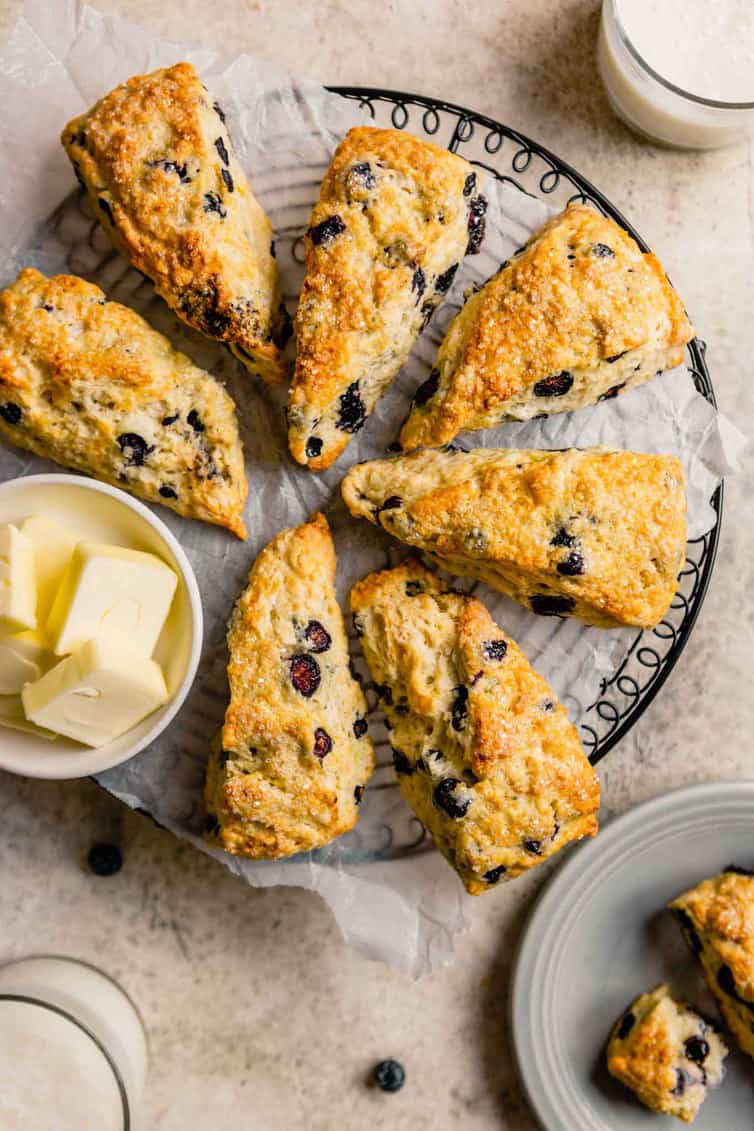
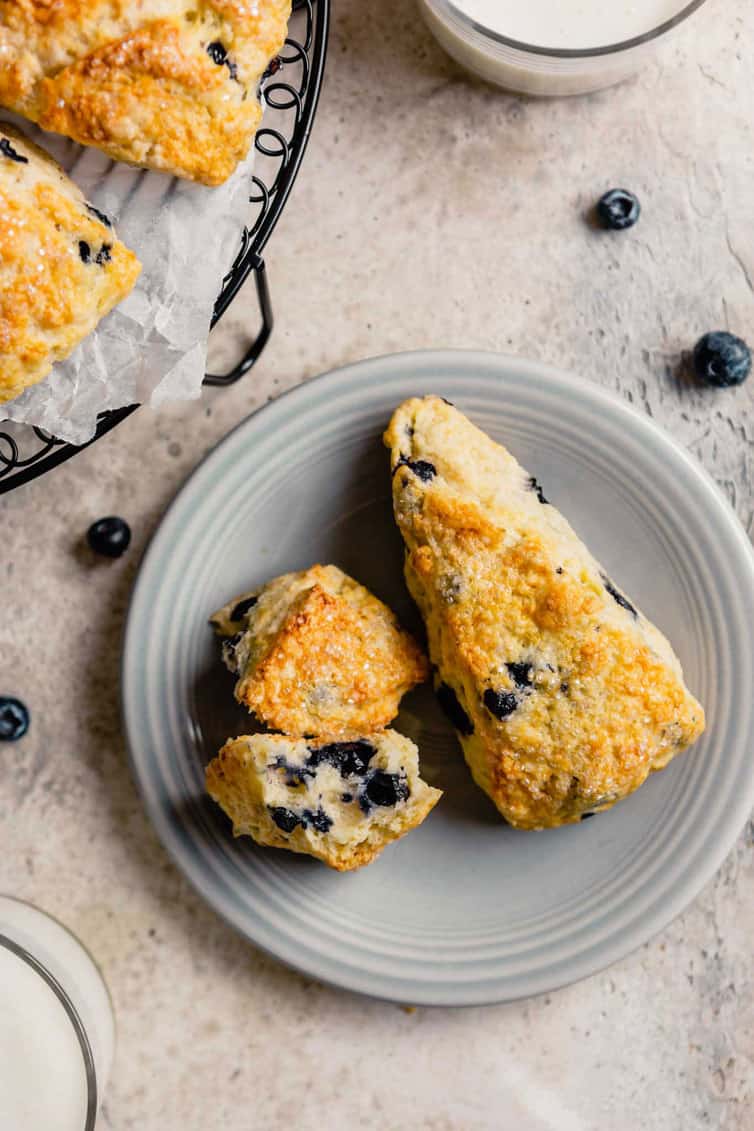
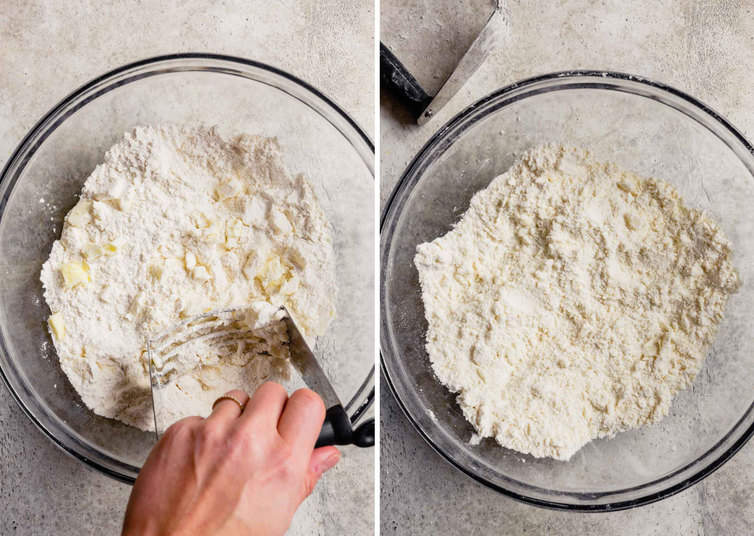
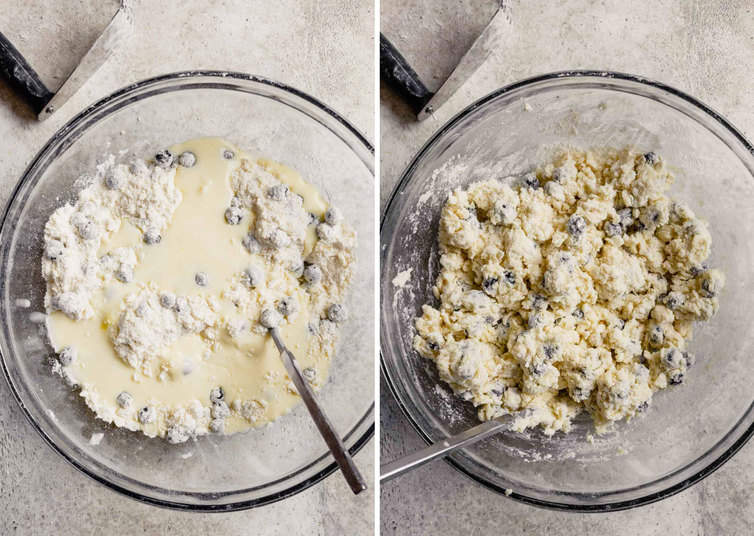
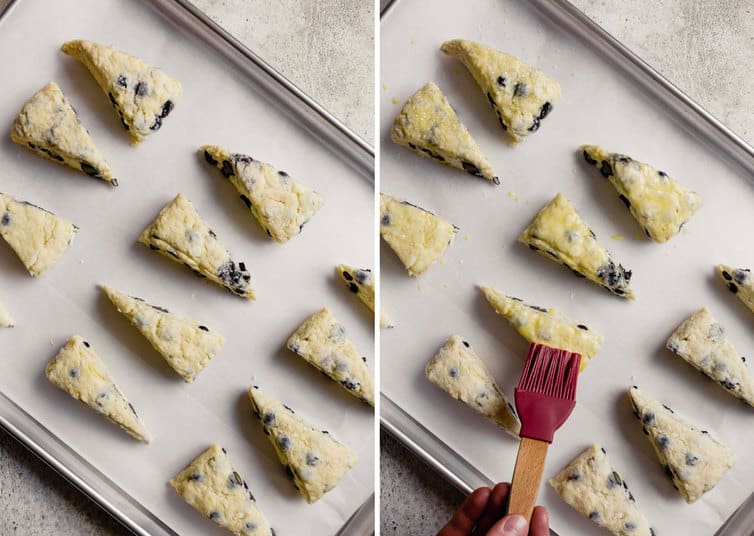
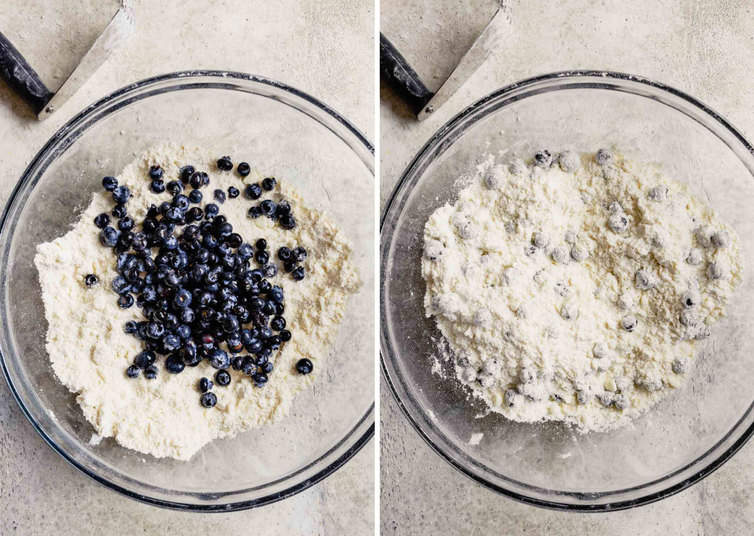
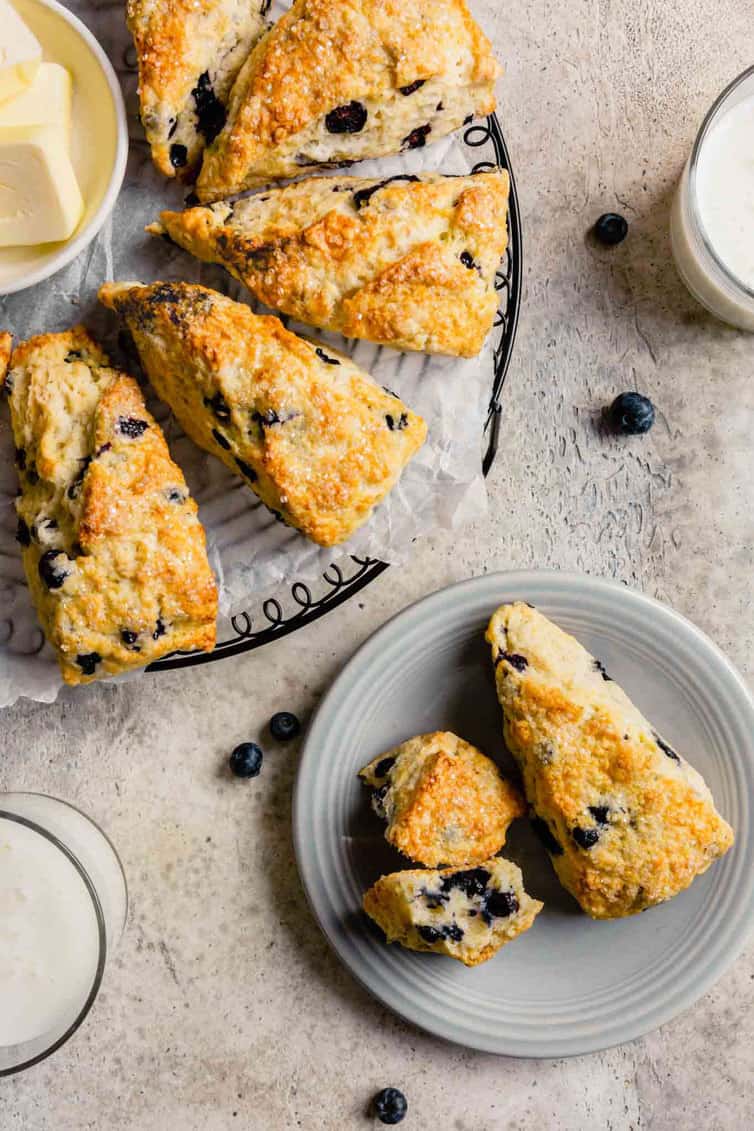



So excited to try this. Permission to copy your recipe :)
https://www.montgomerycountytree.com
I feel like scones are very underrated as far as baked goods are concerned. Personally, I love them
Finally, the perfect scone recipe!!! I made these yesterday. So easy. I didn’t have cake flour so I removed a tablespoon from 1/2 cup of all purpose and added a tablespoon of cornstarch then sifted all the flour together. In the notes it says to add 2 tablespoons of cornstarch to 3/4 cup all purpose flour but that didn’t make sense to me. Seemed like it would be too much flour. I added dried cherries, unsweetened shredded coconut, sliced almonds and a touch of almond extract (in addition to the vanilla). Fabulous perfection…very tender and not too sweet. I may never buy another bakery scone again!!!
So excited to try these for the January Bake-Along. Have you ever tried nuts, like pecans, in scones? Not sure if that’s a thing and was considering splitting my cup of mix-ins between pecans and chocolate chips.
Hi Michelle,
I’m planning to make you scones and was. wondering if I can use frozen blueberries instead of fresh. I noticed someone else asked this question but didn’t see a reply from you? I also have blueberries I froze from the summer.
Thank you so much for this recipe! This will be my first attempt to make scones
Hi Janine, Yes, you could definitely use frozen blueberries. Enjoy the scones!
These look delish! I have a freezer full of frozen blueberries from the summer harvest. Can I use frozen berries in these scones? I use frozen in muffins and they work great but not sure if the scone can handle the extra moisture a frozen berry might give off.
Thanks,
Beth
Hi Beth, Yes absolutely!!
Yay yay, welcome back😊
Scones…lovely recipe to start this year with..
I am never disappointed in your recipes and plus I LOVE scones and wanted to make them for mother’s day brunch….I’m a mom but I love baking so much that it’s like a gift to myself to have the time to do it haha One quick question…Could you substitute the blueberries with other fruits like raspberries or strawberries? or maybe do mixed berry with all three?
Thanks and early happy mother’s day! :-D
Hi Heather, I think you substitute other berries! Enjoy and happy mother’s day to you! :)
These came out PERFECTLY. Light, fluffy and delicious! These scones will be a staple in our house now.
Hi, I was wondering if I could make these lactose free by using lactaid milk and stirring in lemon juice or white vinegar to make cheat buttermilk? Or would that make the scones not as good?
Hi Joanna, I haven’t tried to do a substitute buttermilk with lactose-free milk, so I’m not able to say for sure whether it would work or not, unfortunately :(
I just had these at a friend’s house (yesterday), and she used lactose free milk (1%), and used lemon juice to curdle it. They were wonderful!!
I have read that you can also make buttermilk with almond milk! I haven’t tried it yet.
It was my first time with scones and I am asking myself: “why soooo late?!”. They are so yummy and it is so fast to make them! I’ll have to make your Dark Chocolate Chips Scones for my 8-year-old son, he loves dark chocolate and doesn’t like blueberries ;)
I hope you don’t mind I tweaked your recipe by adding zest of 1/2 lemon. Delish and so easy! Thanks for the great recipe.
I made these the other day and they turned out Very badly. Of course, that’s what I get for doing them in a rush.
I just remade them, correctly, and they are heavenly. I also added the spice glaze from your pumpkin scones and Holy Cow it works nicely. So yum. Thank you so much!
my favorite scone recipes are from Alice’s Tea Cup tea shop in New York. I bought the cookbook and have tried to cook my way through all of them!
The base for their recipes just makes the most flaky, moist scones. But my favorite flavor combination that I’ve made so far has been dried cherries and chocolate chunks!
http://mysceneandherd.blogspot.com/2011/03/cherry-chocolate-scones.html
just made them…..THEY TASTED FANTASTIC!
I think these are the most successful scones I ever made, usually for me they turn out very dry and hard. They aren’t overly sweet and the berries add a whole new dimension to them. I’ve just had dinner and decided to make some scones and even though I was still full I managed to eat one because they smelt so good!
i just made these and they are quite tasty. my dough was a bit wet so i sprinkled a little more flour before cutting them. just wondering, is it supposed to be like this?
Hi Sharon, Just like with any other type of dough, the amount of moisture can be affected by the temperature, humidity, etc. It’s definitely okay to sprinkle with more flour if needed; I do it often with various scones. I’m glad you liked them!
Followed you here from TasteStopping, and this is a GREAT photograph. Vivid and very flattering!
Those pics are AMAZING, I have been returning every now and then just to drool at them. I loved a blueberry scone recipe with an orange glaze from Tyler Florence – not too bad. I wish they had crisped up more like yours did….
Hi Jenifer – Thanks for the glowing review! I hope you enjoy the dark chocolate chip scones – they are my mom’s favorite!
I just made your scones this morning and they were wonderful. I think they would be fabulous with currants, strawberries, just about any fruit in them. I have been scouring the web and cookbooks for “the perfect scone” and I think I found it with yours. Next up is your dark chocolate chip scones.
I’m starting to become a huge fan of scones.
Your scones look delicous!
i {heart} strawberry scones. I love how big and juicy the blueberries are in your scones – I must try this!
Now I know what to do with those extra blueberries I picked this weekend.
You just read my mind. Just seconds before coming over here I was thinking about scones! Now, I’m thinking it must be fate and this recipe needs to be tried out by me ASAP!
I LOVE scones of all sorts, I dont think there is one that I have not liked! Hmmm favorite:
Fall: Pumpkin Spice
Winter: Gingerbread
Spring: Blueberry or Strawberry Choc Chip
Summer: Honey Fresh Fig
My three favorites that I make?
Orange and dark chocolate
Lemon poppy seed
Peanut butter and jelly :). Can’t share that yet as it is entered in the Pillsbury Bakeoff!
These look lovely! I’ve used the cream scones recipe from the book Baking Unplugged. Delicious.
That looks delicious, I am always looking for new blueberry recipes!
Wow, those scones look great! I really need to try and make them on my own!
I love scones, but don’t have a favorite recipe, yet. Yours are just gorgeous.
Oh me-oh my, those are beautiful enough to sashay down a catwalk. I still have blueberries and some leftover buttermilk from some muffins I made last week… I think you’ve inspired another round of baking!
I LOVE SCONES. Thus the name of my blog, but don’t make them as often as I used to. Lavender scones were interesting, but chocolate is very good, I guess blueberry Almond would be my favorite.
Yours look wonderful.
These look perfect!
Here’s mine-
Cream Scone Recipe:
2 cups all-purpose flour
1/4 cup white sugar
2 teaspoons baking powder
1/4 teaspoon salt
1/3 cup cold unsalted butter
, cut into pieces
1 large egg, lightly beaten
1 teaspoon pure vanilla extract
1/2 cup whipping cream or milk
Glaze:
Cream
Preheat oven to 375 degrees F (190 degrees C) and place the rack in the middle of the oven. Line a cookie sheet with parchment paper.
In a large bowl, whisk together the flour, sugar, baking powder and salt. Cut the butter into small pieces and blend into the flour mixture with a pastry blender or two knives. The mixture should look like coarse crumbs. In a small measuring cup combine the whipping cream, beaten egg and vanilla. Add this mixture to the flour mixture. Stir just until combined. Do not over mix.
Knead dough gently on a lightly floured surface. Roll or pat the dough into a circle that is about 7 inches (18 cm) round. Then, using a 2 1/2 inch (6.5 cm) round cookie cutter, cut the dough into rounds. Place the rounds on the prepared cookie sheet, spacing a few inches apart. Brush the tops of the scones with a little cream. This helps to brown the tops of the scones during baking.
Bake for about 15 – 18 minutes or until nicely browned and a toothpick inserted into the center of a scone comes out clean. Remove from oven and transfer to a wire rack to cool. Serve with Devon cream or softly whipped cream and your favorite jam.
These scones freeze very well.
This recipe is from THE JOY OF BAKING
Yum….sounds so yummy. With a pat of butter on top? Heaven.
Scones are one of my favorite breakfast treats! I recently made lemon verbena blueberry scones. They were very tasty! I will have to try these next time!
I LOVE SCONES! I always make them when we have house guests. They are always a big hit. My favorites are cranberry-orange scones and a blueberry coffee cake scone. You can check them out at the cooking blog I post at: barefoot-in-the-kitchen.blogspot.com
I love your website by the way. I can’t wait to have my own cooking site one day. :)
I pretty much love blueberries in any bake goods, especially scones, these look really yummy
You know I have never made scones, but I ALWAYS get a blueberry scone from Panera bread! Chocolate chip, though sounds like it is right up my alley!
Your scones turned out beautiful. And the photography…. ! Really good.
The first picture had me drooling, even though I’ve never tasted scones!! These look soo good, they are making me want to bake some soon!
WOW! looking at the colour really makes me drooling :D
YUM!! Those look so good, blueberry is my favorite!!